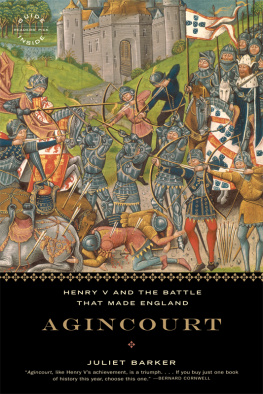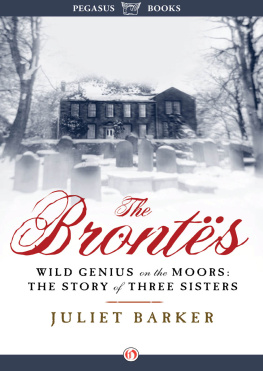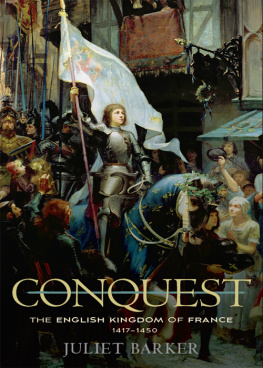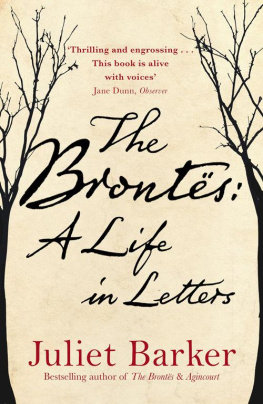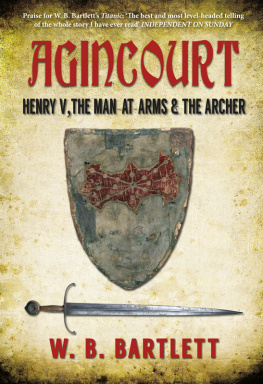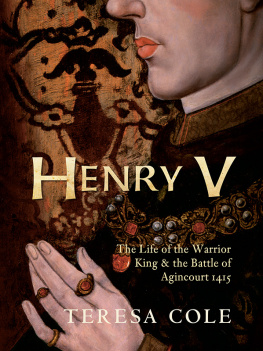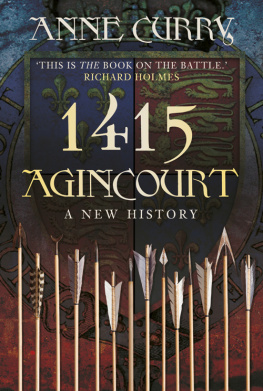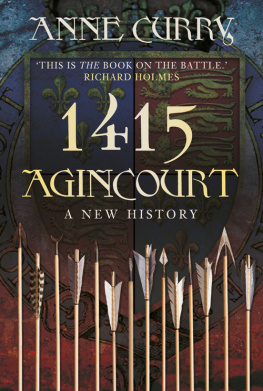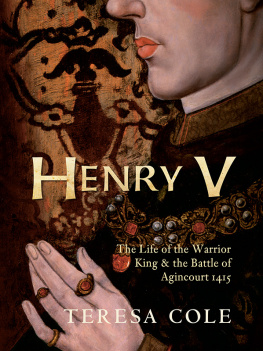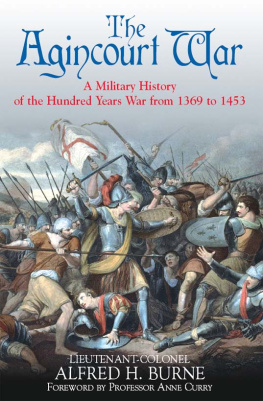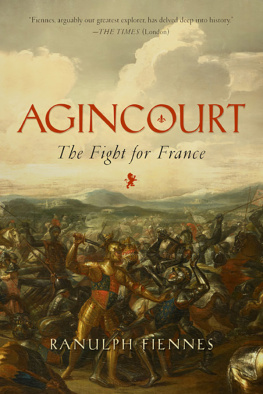Juliet Barker - Agincourt: Henry V and the Battle That Made England
Here you can read online Juliet Barker - Agincourt: Henry V and the Battle That Made England full text of the book (entire story) in english for free. Download pdf and epub, get meaning, cover and reviews about this ebook. year: 2007, publisher: Back Bay Books, genre: Non-fiction. Description of the work, (preface) as well as reviews are available. Best literature library LitArk.com created for fans of good reading and offers a wide selection of genres:
Romance novel
Science fiction
Adventure
Detective
Science
History
Home and family
Prose
Art
Politics
Computer
Non-fiction
Religion
Business
Children
Humor
Choose a favorite category and find really read worthwhile books. Enjoy immersion in the world of imagination, feel the emotions of the characters or learn something new for yourself, make an fascinating discovery.
- Book:Agincourt: Henry V and the Battle That Made England
- Author:
- Publisher:Back Bay Books
- Genre:
- Year:2007
- Rating:3 / 5
- Favourites:Add to favourites
- Your mark:
- 60
- 1
- 2
- 3
- 4
- 5
Agincourt: Henry V and the Battle That Made England: summary, description and annotation
We offer to read an annotation, description, summary or preface (depends on what the author of the book "Agincourt: Henry V and the Battle That Made England" wrote himself). If you haven't found the necessary information about the book — write in the comments, we will try to find it.
Agincourt: Henry V and the Battle That Made England — read online for free the complete book (whole text) full work
Below is the text of the book, divided by pages. System saving the place of the last page read, allows you to conveniently read the book "Agincourt: Henry V and the Battle That Made England" online for free, without having to search again every time where you left off. Put a bookmark, and you can go to the page where you finished reading at any time.
Font size:
Interval:
Bookmark:
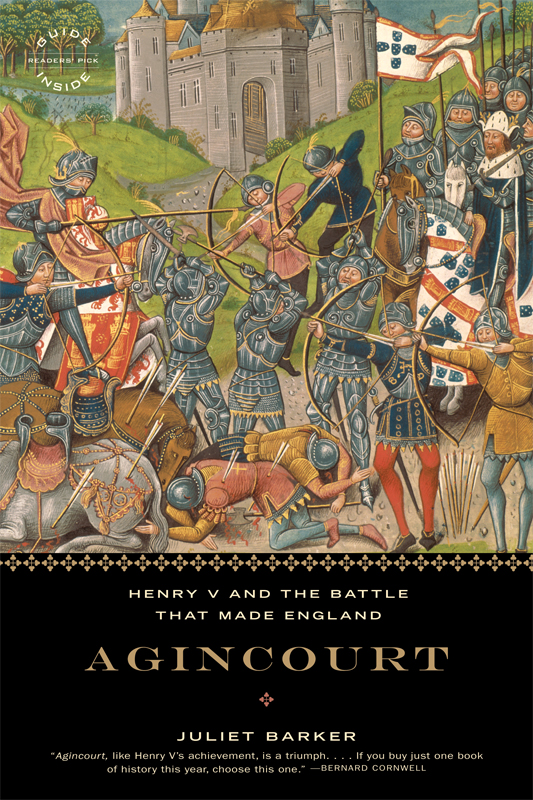
Copyright 2005 by Juliet Barker
All rights reserved. No part of this book may be reproduced in any form or by any electronic or mechanical means, including information storage and retrieval systems, without permission in writing from the publisher, except by a reviewer who may quote brief passages in a review.
Little, Brown and Company,
Hachette Book Group,
237 Park Avenue,
New York, NY 10017
Visit our Web site at www.HachetteBookGroup.com
First eBook Edition: June 2006
ISBN: 978-0-316-05589-5
The Little, Brown and Company Books name and logo are trademarks of Hachette Book Group, Inc.
ALSO BY JULIET BARKER
The Bronts: Selected Poems
The Tournament in England, 1100-1400
Tournaments: Jousts, Chivalry and Pageants in the Middle Ages (with Richard Barber)
The Bront Yearbook
The Bronts
The Bronts: A Life in Letters
Charlotte Bront: Juvenilia, 1829-35
Wordsworth: A Life
Wordsworth: A Life in Letters
For Maurice Hugh Keen
EMERITUS FELLOW OF BALLIOL COLLEGE, OXFORD
As first light dawned on the morning of 25 October 1415, two armies faced each other across a plateau in an obscure corner of north-eastern France. The contrast between them could not have been greater. On one side stood the bedraggled remnants of an English army that had invaded Normandy ten weeks earlier and, in a major blow to French pride, captured the strategically important town and port of Harfleur. The siege had taken its toll, however, and of the twelve thousand fighting men who had embarked on the expedition, only half that number were now assembled on the field of Agincourt. Of these, only nine hundred were men-at-arms, the human tanks of their day, clad from head to toe in plate armour and universally regarded as the elite of the military world. The rest were English and Welsh archers, who wore only the minimum of defensive armour and carried the longbow, a weapon virtually unique to their island. Many of them were suffering from the dysentery that had also incapacitated their comrades: all were exhausted and half-starved after a gruelling eighteen-day march through almost two hundred and fifty miles of hostile terrain, during which they had been constantly harassed, attacked and deflected from their course by the enemy. Even the weather had been against them, biting winds and constant heavy rain adding to their misery as they trudged from Harfleur towards the safety of English-held Calais.
Facing themand blocking their route to Calaiswas a French army that outnumbered them by at least four to one and possibly as much as six to one. Galvanised by the desire to revenge the loss of Harfleur, the chivalry of France had turned up in their thousands from every part of northern France and some from even further afield. So many men-at-arms had answered the call that it was decided to dispense with the services of some of the less well-equipped city militiamen and crossbowmen, and reinforcements continued to arrive even after the battle had begun. With a few notable exceptions, every princeling with a trace of royal blood in his veins was present, together with all the greatest military officers of France. Well rested, well fed, well armed, fighting on their own territory on a site that they had chosen themselves, this army could be forgiven for thinking that the result of the battle was a foregone conclusion.
Yet some four hours later, in defiance of all logic and the received military wisdom of the time, the English were victorious and the fields of Agincourt were covered with what one observer graphically described as the masses, the mounds, and the heaps of the slain. including the dukes of Alenon, Bar and Brabant, eight counts, a viscount and an archbishop, together with the constable, admiral, master of the crossbowmen and prvt of marshals of the French army. Several hundred more, among them the dukes of Orlans and Bourbon, the counts of Richemont, Eu and Vendme, and the celebrated chivalric hero Marshal Boucicaut, were prisoners in English hands. The English, by contrast, had lost only two noblemen, Edward, duke of York, and Michael, earl of Suffolk, a handful of men-at-arms and perhaps a hundred archers. The English victory was so unexpected and so overwhelming in its scale that contemporaries could only ascribe it to God.
For Henry V, however, the battle of Agincourt was not just a divine affirmation of the justice of his cause. It was also the culmination of a carefully planned campaign, preceded by years of meticulous preparation. To see the battle in this context is to understand not only the determination and single-mindedness of the principal human architect of the victory but also the reason why, against all the odds, he was victorious. For these reasons, therefore, this book is not merely a study of the military campaign to which this battle was the dramatic denouement. Agincourt also aims to set the scene in which such a conflict was possible and to explain why, given the character of Henry V, it was almost inevitable. The book falls into three parts. The first deals with the inexorable countdown to war as Henry stamped his authority on his own kingdom, exploited the internal divisions caused by the French civil wars to his own advantage and engaged in diplomacy to ensure that Frances traditional allies did not come to her aid when he attacked. The second part of the book follows the campaign itself, from the moment Henry gave the signal that launched the invasion, through the siege and fall of Harfleur, the increasingly desperate march to Calais, the battle and, finally, the formal concession of defeat by the French heralds. The third part examines the impact of the battle on the victors, on the families of those who lost their lives and on the prisoners, some of whom were to endure years in foreign captivity. It also looks briefly at the wider historical consequences of Agincourt and at the literature that this spectacular victory inspired.
It is no coincidence that many authors have been prompted to write about Agincourt in times of war. When national morale is low and victory seems uncertain or far off, it is useful to be reminded that resourcefulness and determination can sometimes be more important than sheer weight of numbers. On the other hand, writing in such circumstances makes it easy to fall into the propaganda trap, and much of the historical and literary response to Agincourt has been one-sided, politically motivated or simply jingoistic, portraying the battle as a victory of stout-hearted, no-nonsense English commoners over lily-livered, unmanly, foppish French aristocrats. Writing in the aftermath of 9/11 and the invasions of Afghanistan and Iraq by the Americans, the British and their allies, it is impossible not to be struck by the echoes from six centuries ago. But while human nature does not change, the circumstances in which we live and fight our wars do, and it would be wrong to draw too close analogies between the past and the present.
In writing this book, I hope to have done something towards creating a more balanced view of the battle and the events leading up to it. Inevitably, the fact that English administrative, financial and family records have been preserved in far greater numbers than similar ones in France (where most were destroyed during the French Revolution) means that greater emphasis is placed on the English experience, though this is not necessarily inappropriate, given that Henry V was the aggressor. The fascination of the English material is its detail: we learn of the young earl marshals purchase of new armour and equipment (including a pavilion to stable his horses and a new seat for his latrine) for his first military campaign; of the vast household, including everyone from heralds and minstrels to scullery servants and torchbearers, which accompanied the king himself; of the unprecedented expenditure in hiring armourers, fletchers and, most significantly, foreign gunners to operate Henrys huge train of cannon and artillery.
Font size:
Interval:
Bookmark:
Similar books «Agincourt: Henry V and the Battle That Made England»
Look at similar books to Agincourt: Henry V and the Battle That Made England. We have selected literature similar in name and meaning in the hope of providing readers with more options to find new, interesting, not yet read works.
Discussion, reviews of the book Agincourt: Henry V and the Battle That Made England and just readers' own opinions. Leave your comments, write what you think about the work, its meaning or the main characters. Specify what exactly you liked and what you didn't like, and why you think so.

